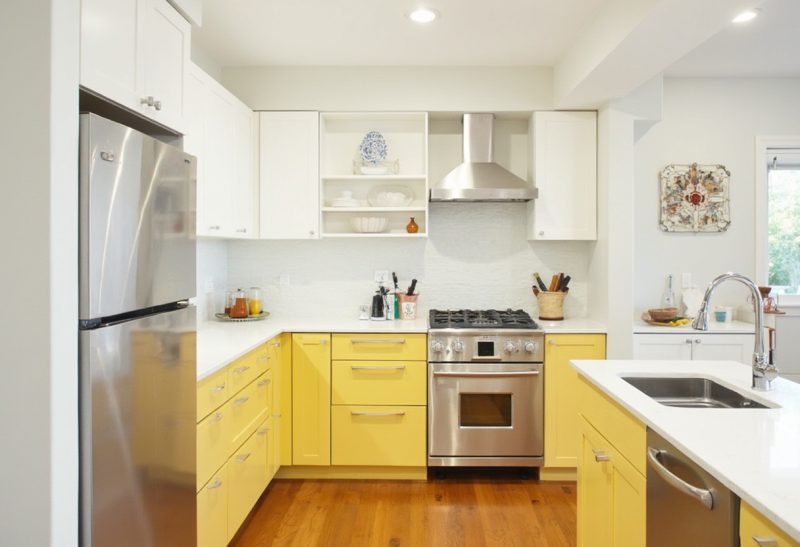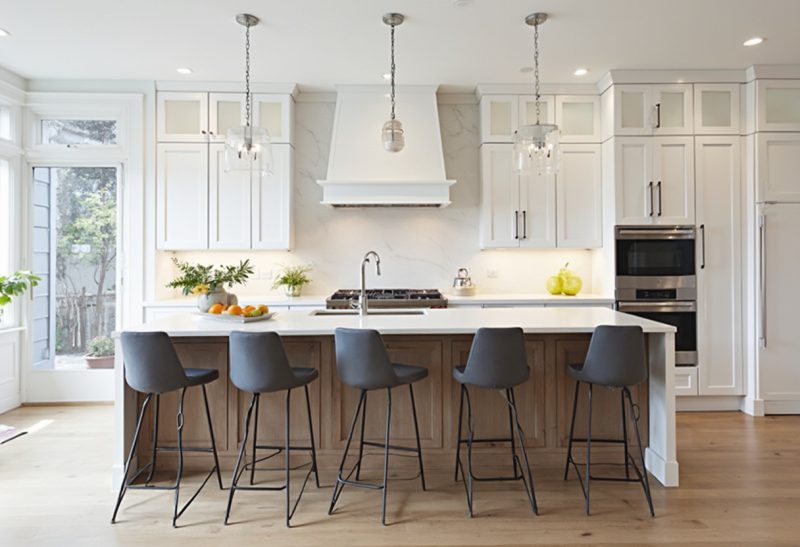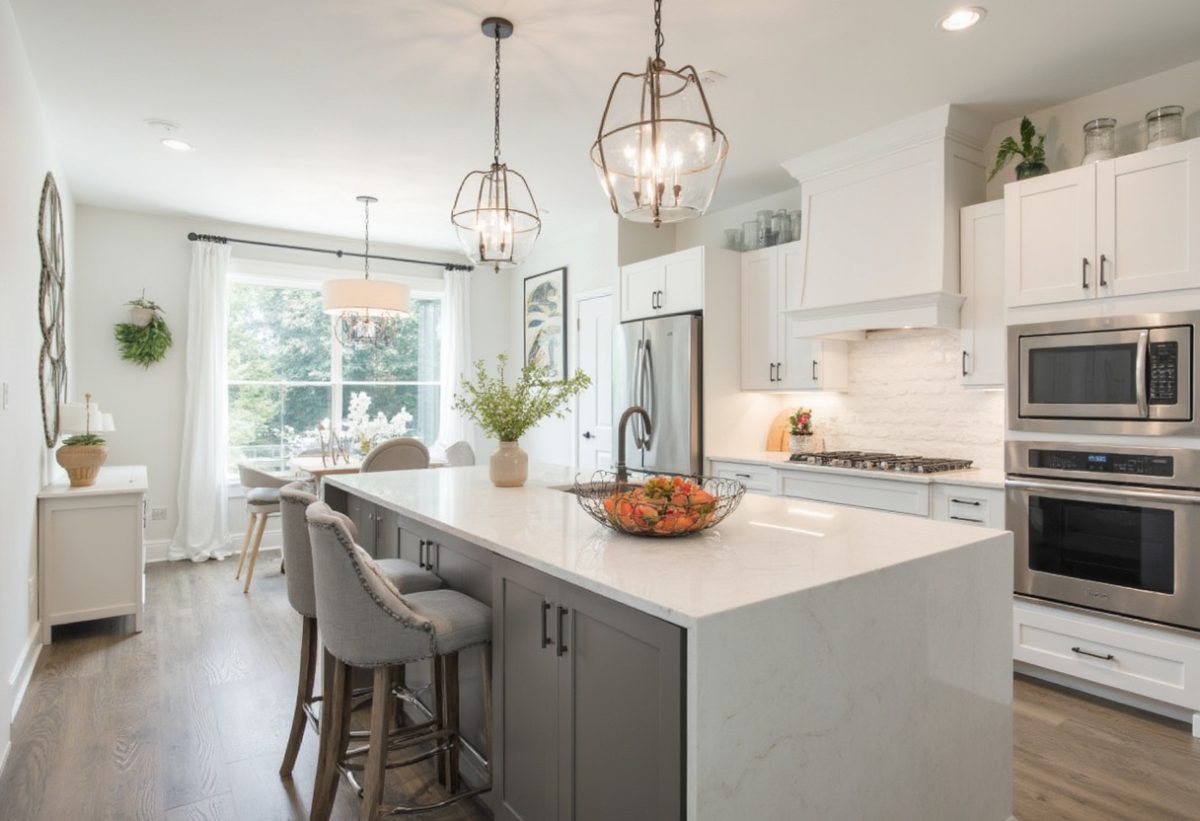1.Understanding the Types of Kitchen Extensions in Toronto
Outward Extensions
Expanding the kitchen by extending it outward into the yard is a great way to increase the space in your home for cooking, dining, and hosting guests. This type of extension adds more square footage to your house and comes with several advantages.
- Increased Floor Space: Outward extensions can significantly enlarge your kitchen, giving you room for a larger island, additional cabinetry, and more counter space
- Open Plan Design: Expanding outward often allows for an open-plan design that seamlessly connects the kitchen to the dining or living area, creating a more sociable environment.
Side-Return Extensions
Expanding into the narrow area beside your house, also known as the “side return,” is called a side-return extension. It’s a favored choice for Toronto homeowners with semi-detached or terraced houses. Some of the main advantages are:
- Utilizing Wasted Space: Side-return extensions make use of the often underutilized space along the side of your home, allowing you to expand the kitchen without sacrificing backyard space.
- Natural Light: By incorporating large windows or glass doors into the side return, you can bring in more natural light, making the kitchen feel brighter and more open.
Rear Extensions
Extending the rear of your house to create a bigger kitchen is known as a rear extension. This type of extension is perfect for people with a spacious backyard who want to blend their indoor and outdoor living spaces. Some of the main advantages are:
- Connection to the Outdoors: Rear extensions often feature large sliding glass doors or bi-fold doors that open directly onto the backyard, creating a seamless transition between the indoor and outdoor spaces.
- Increased Flexibility: A rear extension allows you to create a larger kitchen with space for a dining area, breakfast nook, or even a small family room.
Kitchen Bump-Outs
A kitchen bump-out is a small extension that adds a bit of extra space to the kitchen by pushing out a section of the wall. It might not give as much extra space as a full extension, but it can create enough room for a bigger island, pantry, or more cabinets.
2. Zoning and Building Permits for Kitchen Extensions in Toronto
Before you start building anything, it’s important to have a good grasp of Toronto’s zoning regulations and the building permits needed for adding a kitchen extension. These rules make sure that your project meets the local building codes and doesn’t infringe on any property restrictions.
Zoning Laws
When planning to extend your kitchen in Toronto, it’s important to make sure that your project follows the zoning bylaws, which control property development and the construction of different types of buildings.
- Setback Requirements: Zoning laws often dictate how far an extension must be set back from the property line. Depending on the size of your lot, setback requirements may limit how far you can extend the kitchen outward.
- Lot Coverage: Zoning bylaws also limit the total percentage of your lot that can be covered by structures. If your home already occupies a large portion of the lot, you may need to adjust the size of the extension to comply with these restrictions.
- Height Restrictions: While most kitchen extensions are single-story additions, it’s important to ensure that your project complies with height restrictions in your neighborhood, especially if you’re adding a second story as part of the home renovation.
Building Permits
- Submitting Detailed Plans: Your contractor or architect will need to submit detailed plans to the city that outline the design of the extension, including structural, electrical, and plumbing modifications.
- Structural Inspections: The city may require inspections to ensure that the foundation and structural components of the extension are built to code.
- Electrical and Plumbing Permits: If your kitchen extension involves adding new electrical wiring, outlets, or plumbing fixtures, you’ll need additional permits to ensure compliance with safety regulations.
It’s really important to get the right permits before starting any construction work in Toronto. If you don’t, you could end up with fines, delays, and even safety issues. That’s why it’s crucial to hire experts who know their way around Toronto’s permit system.

3.Designing Your Kitchen Extension
An intelligently planned kitchen extension has the potential to entirely change the way you utilize your living space. Carefully considered design decisions will optimize the usability of the area and guarantee that the extension harmonizes with the overall look of your home.
Layout and Space Planning
When planning your kitchen extension, the arrangement of the space is crucial. A well-thought-out layout can improve the efficiency and enjoyment of using the kitchen. There are several common kitchen layouts to consider.
- L-Shaped Kitchen: This layout features countertops and cabinets arranged along two perpendicular walls, forming an L shape. It’s ideal for creating a spacious and open feel in larger kitchens.
- U-Shaped Kitchen: The U-shaped layout wraps around three walls, providing plenty of counter space and storage. This layout is perfect for creating a highly functional kitchen with dedicated zones for cooking, prep work, and cleaning.
- Island Layout: Kitchen islands are a popular feature in modern kitchens. They provide additional counter space, seating, and storage, and can serve as the focal point of the kitchen. When designing your extension, consider whether there is enough space for a central island.
Maximizing Natural Light
To make your kitchen feel bright and inviting, it’s important to let in as much natural light as possible. You can achieve this by including big windows, skylights, or glass doors in your extension design. These elements will fill the space with light, creating an open and airy atmosphere. Common choices for this include:
- Bi-Fold or Sliding Glass Doors: These doors open up the back of the kitchen to the outdoors, creating a seamless connection between the kitchen and the backyard. They also allow natural light to pour into the space.
- Skylights: Skylights are a great way to let natural light into a room, especially in kitchen extensions with flat roofs or ceilings. They can be positioned above important areas like the kitchen island or dining table to make the space bright and well-lit for working.
Choosing Materials and Finishes
The materials and finishes you select for your kitchen extension will greatly influence the overall appearance and atmosphere of the area. Common options for kitchen extensions include:
- Countertops: Quartz, granite, and marble are durable and attractive options for kitchen countertops. Quartz is particularly popular for its low maintenance and wide variety of colors and patterns.
- Cabinetry: Custom cabinetry can be designed to maximize storage and fit the specific dimensions of your kitchen. Choose high-quality materials such as solid wood or engineered wood for a long-lasting and elegant look.
- Flooring: Hardwood, tile, and luxury vinyl are popular choices for kitchen flooring. Each material has its pros and cons, so consider factors such as durability, maintenance, and aesthetic when selecting the right flooring for your kitchen extension.
4. Incorporating Modern Kitchen Technology
When you’re expanding your kitchen, consider adding new appliances and smart kitchen technology to make the space more functional and convenient.
Energy-Efficient Appliances
When choosing new appliances for your kitchen extension, it’s a good idea to pick energy-efficient models with high Energy Star ratings. This not only lowers your energy costs but also makes your home addition more sustainable.
- Induction Cooktops: Induction cooktops offer faster cooking times and greater energy efficiency compared to traditional gas or electric ranges.
- Smart Refrigerators: Smart refrigerators feature touchscreen displays, built-in cameras, and Wi-Fi connectivity, allowing you to manage grocery lists, check expiration dates, and adjust temperature settings from your smartphone.
- Dishwashers with Eco Settings: Many modern dishwashers come with eco-friendly wash cycles that use less water and energy, making them a great addition to an energy-efficient kitchen.
Smart Kitchen Technology
Adding smart kitchen technology to your extension can enhance how convenient and functional the space is. Some popular smart devices for the kitchen are:
- Smart Lighting: Smart lighting systems allow you to control the brightness and color of your kitchen lights with a smartphone app or voice commands. This can be particularly useful in creating different lighting zones for cooking, dining, and entertaining.
- Voice-Controlled Assistants: Devices such as Amazon Echo or Google Home can be used to set timers, play music, or control smart appliances hands-free, making it easier to multitask while cooking.
- Smart Thermostats: A smart thermostat can help you regulate the temperature in your kitchen extension, ensuring it stays comfortable year-round without wasting energy.

5. Kitchen Extension Toronto Costs
Planning a kitchen extension requires careful budgeting to cover all expenses. In Toronto, the cost of a kitchen extension can vary widely, typically ranging from $25,000 to $100,000 or even higher, depending on factors such as size, complexity, and choice of materials.
Factors Affecting Cost
Several factors can influence the total cost of your kitchen extension:
- Size of the Extension: Larger extensions will require more materials and labor, increasing the overall cost. Adding extra features such as a dining area or pantry will also affect the price.
- Quality of Materials: High-end materials such as custom cabinetry, quartz countertops, and hardwood flooring will drive up the cost of the project. If you’re working with a tight budget, consider choosing more affordable materials that offer a similar aesthetic without the high price tag.
- Labor Costs: Labor costs in Toronto can vary depending on the contractor’s experience and the complexity of the project. Be sure to get multiple quotes from reputable contractors like Maple Star Builders to find one that offers competitive pricing.
Contingency Fund
It’s crucial to allocate a contingency fund in your budget to account for any unforeseen expenses. A general guideline is to reserve 10-15% of the overall budget for unexpected costs like unforeseen building issues or rises in material prices.
6. The Construction Process for a Kitchen Extensions in Toronto
Once you’ve settled on the design and obtained all the required permits, it’s time to start building your kitchen extension. Knowing the important steps of the construction process will help you anticipate any inconveniences and keep the project moving forward as planned.
Site Preparation
Before construction begins, the worksite will need to be prepared. This includes:
- Demolition: If the extension involves expanding into an existing room, such as a dining area or laundry room, demolition work may be necessary to create space for the new kitchen.
- Excavation: For outward extensions, excavation work will be required to prepare the foundation for the new structure.
Foundation and Framing
After the site is ready, we will start by laying the foundation and then proceed to build the walls, floor, and roof of the new kitchen extension. This stage also involves putting in any new windows or doors.
Plumbing, Electrical, and HVAC
The next step involves installing the necessary utilities for the kitchen. This includes running new plumbing lines for the sink and appliances, installing electrical outlets and lighting, and ensuring the HVAC system can properly heat and cool the extended space.
Interior Finishing
Once the structural work and utilities are in place, the interior finishing can begin. This includes:
- Drywall and Insulation: Insulating the walls and installing drywall to create a comfortable and energy-efficient kitchen.
- Flooring and Cabinetry: Laying the new flooring and installing custom cabinetry and countertops.
- Appliance Installation: Installing new appliances, such as the refrigerator, oven, and dishwasher.
Expanding your kitchen is a great way to improve your home in Toronto. Whether you choose to extend outwards, to the side, or to the rear, a well-designed kitchen renovation can make a big difference in how you use your home. It’s important to carefully plan the layout, select quality materials, and incorporate modern technology to create a space that will be the heart of your home for years to come. Working with experienced professionals to ensure the project follows Toronto’s regulations and obtaining the necessary permits is crucial. It’s also important to set a realistic budget that covers all aspects of the construction process. Contact Maple Star Builders today for a consultation tailored to Toronto’s climate, codes, and your lifestyle. Let’s turn your renovation vision into reality!
References
- City of Toronto – Zoning By-Laws.
City of Toronto. Available at: https://www.toronto.ca/services-payments/building-construction/ - City of Toronto – Building Permits and Information.
City of Toronto. Available at: https://www.toronto.ca/services-payments/building-construction/apply-for-a-building-permit/ - Houzz – Kitchen Extension Ideas and Inspiration.
Houzz. Available at: https://www.houzz.com/photos/query/kitchen-extension - HGTV – Kitchen Extension Tips.
HGTV. Available at: https://www.hgtv.com/design/remodel/kitchen-remodel - Energy Star – Energy-Efficient Appliances.
Energy Star. Available at: https://www.energystar.gov/products - Smart Home Guide – Kitchen Tech.
Smart Home Guide. Available at: https://www.pcmag.com/picks/the-best-smart-kitchen-appliances - Remodeling Magazine – Kitchen Addition Costs.
Remodeling Magazine. Available at: https://www.remodeling.hw.net/cost-vs-value/2024/ - HomeStars – Kitchen Renovation Costs in Toronto.
HomeStars. Available at: https://homestars.com/cost-guides/on/kitchen-renovation-cost-toronto/ - Canada Green Building Council – Sustainable Home Renovations.
Canada Green Building Council. Available at: https://www.cagbc.org/


